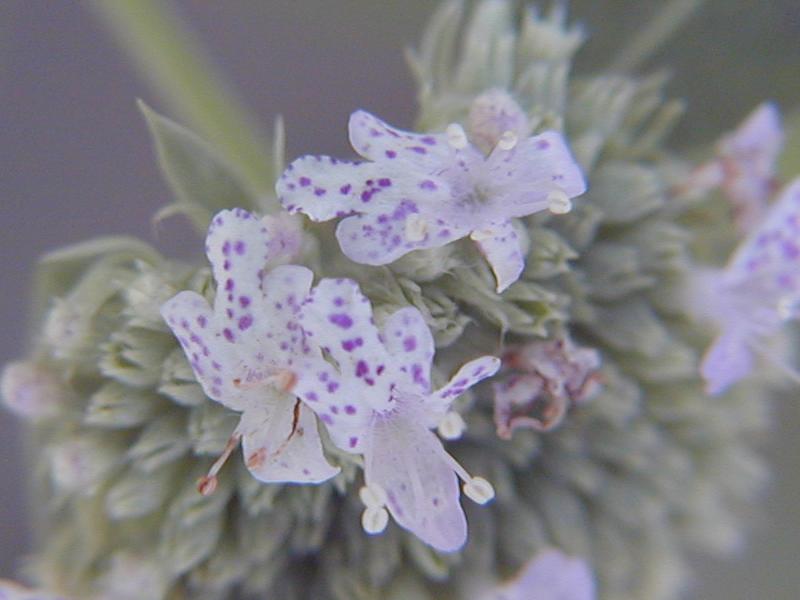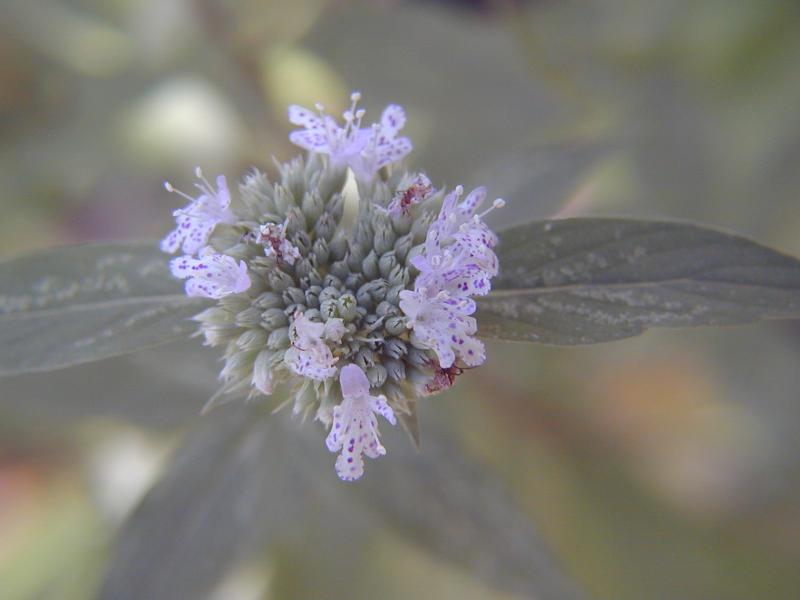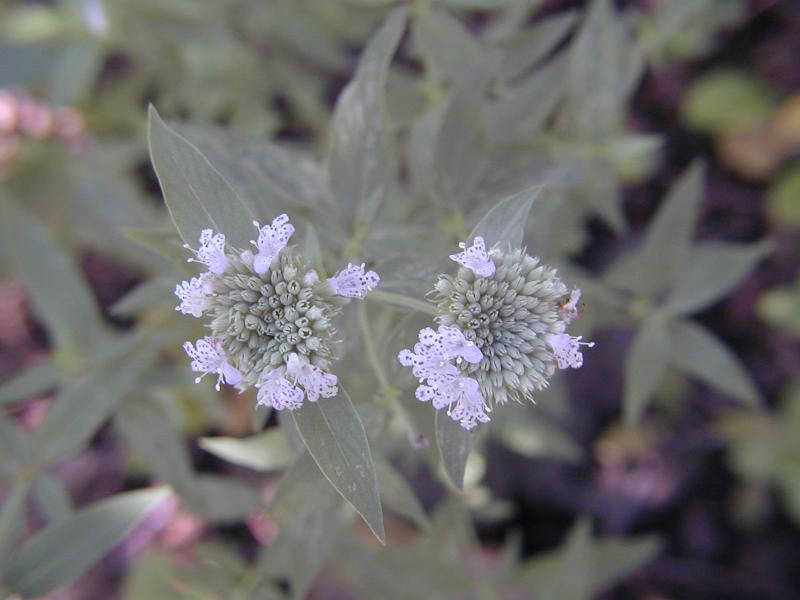Basil Mountain Mint
Pycnanthemum clinopodioides Torr. & Gray
- Class
- Dicotyledoneae (Dicots)
- Family
- Lamiaceae (Mint Family)
- State Protection
- Endangered
Listed as Endangered by New York State: in imminent danger of extirpation in New York. For animals, taking, importation, transportation, or possession is prohibited, except under license or permit. For plants, removal or damage without the consent of the landowner is prohibited.
- Federal Protection
- Not Listed
- State Conservation Status Rank
- S1
Critically Imperiled in New York - Especially vulnerable to disappearing from New York due to extreme rarity or other factors; typically 5 or fewer populations or locations in New York, very few individuals, very restricted range, very few remaining acres (or miles of stream), and/or very steep declines.
- Global Conservation Status Rank
- G1G2
Critically Imperiled or Imperiled globally - At very high or high risk of extinction due to rarity or other factors; typically 20 or fewer populations or locations in the world, very few individuals, very restricted range, few remaining acres (or miles of stream), and/or steep declines. More information is needed to assign either G1 or G2.
Summary
Did you know?
This species has the smallest range of any northeastern Pycnanthemum. It was first collected in New York in 1817 with reports continuing up until 1893. This plant was thought to be extirpated from New York, but after a 104 year absence it was rediscovered. Since its rediscovery, two new sites have been located. The species name derives from its resemblance to the European calamint, Clinopodium.
State Ranking Justification
There are three known populations but two of these are quite small. One population is greatly threatened by competition from aggressive non-native plants. This plant is likely limited to the trapp rock along the Palisades, but disjunct populations may be encountered in calcareous areas where numerous other Pycnanthemum species are located.
Short-term Trends
Populations have been recently discovered and no short-term trends have been established. After missing from the New York flora for over a hundred years, it is unclear if it was here alll along or if this plant is expanding its range.
Long-term Trends
Historically, this plant was known from northern Manhattan and southern Westchester County. These historical sites are considered extirpated, but new populations have been discovered in the Palisades and Harlem Valley. Two of these populations are very small. Most likely, this plant is far less common today than it was 200 years ago but there is little evidence to support this statement.
Conservation and Management
Threats
Populations are threatened by succession due to lack of fire and by the encroachment of invasive plants, especially black swallowwort (Cynanchum spp.). One population may be affected by hybridization with other Pycnanthemum species at the site.
Conservation Strategies and Management Practices
This species is greatly threatened by succession and aggressive non-native plants. Aggressive non-native plants should be eliminated from sites supporting this mint and a regular fire regime should be considered to reduce the impact of natural succession.
Research Needs
There are still questions regarding the taxonomy of this species. More specifically, it is not clear if this represents a hybrid or is now a true species with hybrid origins. A range wide review of the entire genus is desired.
Habitat
Habitat
In New York Pycnanthemum clinopodioides has been found on dry on south or west-facing slopes on rocky soil. These sites are open oak-hickory forests, woodlands, or savannas, with lots of exposed bedrock. This plant may prefer alkaline soil conditions, as several of the sites are on trapprock (diabase, a typically high-pH igneous rock) or calcareous bedrock. (New York Natural Heritage Program 2007). Locally near the coast (Gleason & Cronquist 1991). Dry to moist wooded slopes, thickets and shores, rather local (Fernald 1970).
Associated Ecological Communities
- Appalachian oak-hickory forest
(guide)
A hardwood forest that occurs on well-drained sites, usually on ridgetops, upper slopes, or south- and west-facing slopes. The soils are usually loams or sandy loams. This is a broadly defined forest community with several regional and edaphic variants. The dominant trees include red oak, white oak, and/or black oak. Mixed with the oaks, usually at lower densities, are pignut, shagbark, and/or sweet pignut hickory.
- Calcareous red cedar barrens
(guide)
A small-patch calcareous rocky summit community occurring on dry, south-facing to southwest-facing slopes and low summits. These sites are characterized by stunted, sparse woodlands with small grassland openings.
- Rocky summit grassland
(guide)
A grassland community that occurs on rocky summits and exposed rocky slopes of hills. Woody plants are sparse and may be scattered near the margin of the community. Small trees and shrubs may be present at low percent cover.
Associated Species
- Acer saccharum (sugar maple)
- Aster undulatus
- Carex foenea (hay sedge)
- Carex pensylvanica (Pennsylvania sedge)
- Carya glabra (pignut hickory)
- Carya ovata
- Celtis occidentalis (northern hackberry)
- Corydalis sempervirens
- Danthonia compressa (northern oat grass)
- Deschampsia flexuosa
- Desmodium paniculatum (panicled tick-trefoil)
- Fraxinus americana (white ash)
- Leersia virginica (white cut grass)
- Panicum linearifolium
- Parthenocissus quinquefolia (Virginia-creeper)
- Polygonum tenue (pleated-leaved knotweed)
- Pycnanthemum incanum
- Pycnanthemum tenuifolium (narrow-leaved mountain-mint)
- Pycnanthemum virginianum (Virginia mountain-mint)
- Quercus montana (chestnut oak)
- Quercus rubra (northern red oak)
- Sassafras albidum (sassafras)
- Solidago canadensis
- Sorghastrum nutans (Indian grass)
- Tilia americana var. americana (American basswood)
- Triodanis perfoliata (common Venus's looking-glass)
- Viburnum rafinesquianum
Range
New York State Distribution
This plant is only known from alkaline to circumneutral areas with shallow soil of the Palisades and Harlem Valley. Historically, this plant was collected from upper Manhattan near Inwood and possibly other nearby locations.
Global Distribution
As a globally rare plant with relatively specific habitat requirements, distribution is localized. Currently known from Massachusetts, Maryland, Connecticut, New York, New Jersey, Pennsylvania, Delaware, District of Columbia, West Virginia, and North Carolina. There is apparently a disjunct population in Indiana. Reported (but unconfirmed and maybe misidentified?) from Texas. The core of its range is limited to southern New York, northern New Jersey, eastern Pennsylvania, and Maryland.
Identification Comments
General Description
Basil mountain-mint is a perennial wildflower that grows up to a meter tall. It has square branching stems that are covered with short, curved hairs mixed with longer, straight hairs. The leaves are relatively narrow, mostly more than 3 times as long as wide, lance-shaped and with very short leaf stalks. The upper leaf surface has scattered hairs and the lower surface has longer hairs especially on the main veins. The branches are topped by loose clusters of small, light lavender, purple-spotted flowers. In fruit the flower clusters are loose enough to see the individual branchlets inside.
Identifying Characteristics
The stem of this mint, as with most mints, is square. This mint's stem is also pubescent with short-curving and longer-spreading hairs. The leaves are relatively narrow, mostly more than 3 times as long as wide, lanceolate, acuminate, and tapering to petioles. The inflorescences are relatively loose and many of the flower cluster branchlets are evident in fruit. The calyx is 3.5- 5mm. The calyx teeth are deltoid to acuminate and unequal with the lower ones 0.5-2 mm.
Best Life Stage for Proper Identification
This plant cannot be identified definitively without fruit or flowers. An entire plant with the stem, leaves, and inflorescences should be collected to allow for proper verification.
Similar Species
Other narrow leaved mountain mints from similar habitat (Pycnanthemum verticillatum, P. virginianum, P. torrei, and P. tenuifolium) generally have a more compact flowering head and calyx lobes that are all of equal lengths. Another similar mountain mint (Pycnanthemum incanum) will generally have wider leaves (1.5-5 cm wide) with irregular teeth and very hairy leaves.
Best Time to See
This mint flowers from early August to early September. Fruits may persist to early November, long after the leaves have succumbed to frost. Surveys for this plant should occur in August to mid-September when one is likely to find the plant in flower and/or fruit with the leaves still in good condition.
- Flowering
- Fruiting
The time of year you would expect to find Basil Mountain Mint flowering and fruiting in New York.
Basil Mountain Mint Images
Taxonomy
Basil Mountain Mint
Pycnanthemum clinopodioides Torr. & Gray
- Kingdom Plantae
- Phylum Anthophyta
- Class Dicotyledoneae
(Dicots)
- Order Lamiales
- Family Lamiaceae (Mint Family)
- Order Lamiales
- Class Dicotyledoneae
(Dicots)
- Phylum Anthophyta
Additional Common Names
- Clinopod Mountain Mint
- Mountain-mint
Synonyms
- Koellia clinopodioides (Torrey & A. Gray) Kuntze
- Pycnanthemum incaum x virginianum
Comments on the Classification
Sometimes thought to reflect a hybridization of Pycnanthemum incanum and Pycnanthemum verticillatum.
Additional Resources
Best Identification Reference
Grant, E., and C. Epling. 1943. A study of Pycnanthemum (Labiatae). University of California Press, Berkeley and Los Angeles. University of California Publication in Botany 20:195-240.
Other References
Fernald, M.L. 1950. Gray's manual of botany. 8th edition. D. Van Nostrand, New York. 1632 pp.
Gleason, Henry A. and A. Cronquist. 1991. Manual of Vascular Plants of Northeastern United States and Adjacent Canada. The New York Botanical Garden, Bronx, New York. 910 pp.
Holmgren, Noel. 1998. The Illustrated Companion to Gleason and Cronquist's Manual. Illustrations of the Vascular Plants of Northeastern United States and Adjacent Canada. The New York Botanical Garden, Bronx, New York.
Mitchell, Richard S. and Gordon C. Tucker. 1997. Revised Checklist of New York State Plants. Contributions to a Flora of New York State. Checklist IV. Bulletin No. 490. New York State Museum. Albany, NY. 400 pp.
New York Natural Heritage Program. 2010. Biotics database. New York Natural Heritage Program. New York State Department of Environmental Conservation. Albany, NY.
New York Natural Heritage Program. 2024. New York Natural Heritage Program Databases. Albany, NY.
Reschke, Carol. 1990. Ecological communities of New York State. New York Natural Heritage Program, New York State Department of Environmental Conservation. Latham, NY. 96 pp. plus xi.
Weldy, T. and D. Werier. 2010. New York flora atlas. [S.M. Landry, K.N. Campbell, and L.D. Mabe (original application development), Florida Center for Community Design and Research http://www.fccdr.usf.edu/. University of South Florida http://www.usf.edu/]. New York Flora Association http://newyork.plantatlas.usf.edu/, Albany, New York
Links
About This Guide
Information for this guide was last updated on: February 15, 2005
Please cite this page as:
New York Natural Heritage Program. 2024.
Online Conservation Guide for
Pycnanthemum clinopodioides.
Available from: https://guides.nynhp.org/basil-mountain-mint/.
Accessed July 26, 2024.


